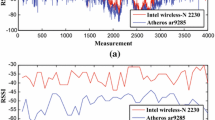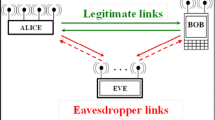Abstract
The wireless physical channel parameters are recently used to provide secret key. However, the key generation usually suffers from the quantization errors due to the noise, which decreases the key agreement ratio (KAR) between authorized users. Most existing approaches achieve high KAR by discarding some channel parameters which may lower the key generation efficiency and therefore lower the encryption strength. In the frequency-division duplex (FDD) systems, the number of reciprocal parameters, such as the multipath angle and delay, is limited. Therefore how to find a quantization method with high KAR and encryption strength is one of the major problems for secret key generation in FDD systems. In this paper, a robust quantization scheme based on grouping and shifting is proposed, in which all the available parameters are used for key generation. In addition, a key mapping method with error correction based on Chinese remainder theorem (CRT) is proposed to further improve the KAR performance. Simulations demonstrate the effectiveness of the proposed method.
Similar content being viewed by others
Explore related subjects
Discover the latest articles and news from researchers in related subjects, suggested using machine learning.References
Li X H, Hwu J, Ratazzi E P. Using antenna array redundancy and channel diversity for secure wireless transmissions. J Commun, 2007, 2: 24–32
Sayeed A, Perrig A. Secure wireless communications: Secret keys through multipath. In: Proceedings of IEEE International Conference on Acoustics, Speech, and Signal Processing (ICASSP’08), 2008. 3013-3016
Wallace J, Sharma R K. Automatic secret keys from reciprocal MIMO wireless channels: measurement and analysis. IEEE Trans Inform Forens Secur, 2010, 5: 381–391
Wallace J. Secure physical layer key generation schemes: performance and information theoretic limits. In: Proceedings of IEEE ICC, Dresden, 2009. 1-5
Aono T, Higuchi K, Ohira T, et al. Wireless secret key generation exploiting reactance-domain scalar response of multipath fading channels. IEEE Trans Anten Propag, 2005, 53: 3776–3784
Czylwik, A. Downlink beamforming for mobile radio systems with frequency division duplex. In: Proceedings of IEEE International Symposium on Personal, Indoor and Mobile Radio Communications, 2000. 72–76
Steinbauer M, Molisch A F, Bonek E. The double-directional radio channel. IEEE Anten Propag, 2001, 43: 51–63
Liang Y C, Chin F, Kot A. Downlink channel covariance matrix (DCCM) estimation for FDD SDMA. In: Proceedings of IEEE Vehicular Technology Conference, 2002. 2382–2386
Goldreich O, Ron D, Sudan M. Chinese Remaindering with Errors. IEEE Trans Inform Theory, 2000, 46: 1330–1338
Mandelbaum D M. On a class of arithmetic codes and a decoding algorithm. IEEE Trans Inform Theory, 1976, 1: 85–88
Wang J Z, Milstein L B. CDMA overlay situations for microcellular mobile communications. IEEE Trans Commun, 1995, 43: 603–614
Wang J Z, Chen J. Performance of wideband CDMA with complex spreading and imperfect channel estimation. IEEE J Sel Area Commun, 2001, 19: 152–163
Raleigh G C, Paulraj A. Time varying vector channel estimation for adaptive spatial equalization. In: Proceedings of IEEE Globecom, 1995. 218–224
3GPP. Spatial channel model for Multiple Input Multiple Output (MIMO) simulations (Rel.6). TR 25.996.V6.1.0. 2003
Ding C, Pei D, Salomaa A. Chinese remainder theorem: applications in computing, coding, cryptography. World Scientif, 1999
Wang W J, Xia X G. A closed-form robust Chinese remainder theorem and its performance analysis. IEEE Trans Signal Process, 2010, 58: 5655–5666
Chan H, Perrig A, Song D, Random key predistribution schemes for sensor networks. In: Proceedings of IEEE Symposium on Security and Privacy, 2003. 197-213
Alle-Jan van der Veen, Vanderveen M, Paulraj A. Joint angle and delay estimation using shift-invariance techniques. IEEE Trans Signal Process, 1998, 46: 405–418
Author information
Authors and Affiliations
Corresponding author
Rights and permissions
About this article
Cite this article
Wang, W., Jiang, H., Xia, X. et al. A wireless secret key generation method based on Chinese remainder theorem in FDD systems. Sci. China Inf. Sci. 55, 1605–1616 (2012). https://doi.org/10.1007/s11432-012-4570-2
Received:
Accepted:
Published:
Issue Date:
DOI: https://doi.org/10.1007/s11432-012-4570-2




